|
|
|
Sort Order |
|
|
|
Items / Page
|
|
|
|
|
|
|
| Srl | Item |
| 1 |
ID:
132043
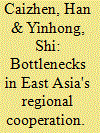

|
|
|
|
|
| Publication |
2014.
|
| Summary/Abstract |
The Problems Facing Regional Cooperation in East Asia great efforts are being made in East Asia to improve regional and Gsub-regional multilateral cooperation in the face of a bottleneck. The key issues are listed below:
First, there is a mismatch between size and effectiveness. Generally speaking, the larger the cooperation organization the more con?icts that arise and thus the less effective they are. Because of efforts by countries such as the U.S.,2 Australia, Japan, and India to further their strategic or diplomatic interests, these organizations are growing in regional coverage, which causes issues to become diversified and in turn causes the organizations to lose sight of their mission. Subsequently, many regional or trans-regional multilateral organizations such as APEC, the East Asia Summit (EAS), and the ASEAN Security Forum are increasingly playing aless effective role. For example, APEC summits and the EAS usually just
end up with a symbolic proclamation without any substance or ' Han Caizhen is Professor at the School of lntemational Studies, Renmin University of China. Shi Yinhong is Counselor at the Counselors' Office at the State Council and Professor at the School of lntemational Studies, Renmin University ot'China
|
|
|
|
|
|
|
|
|
|
|
|
|
|
|
|
| 2 |
ID:
132046


|
|
|
|
|
| Publication |
2014.
|
| Summary/Abstract |
With rapid China now the world's second-largest economy, the status and Wrole of China's think tanks have become an increasing concern. On the whole, the international status of China' s think tanks is not
commensurate with the country' s current international status. The University of Pennsylvania' s The Global Go To Think Tanks Report published in 2014 said that as of August 2013, China had 426 think tanks, second only to the U.S. with 1,828. But of the top 100 non-U.,S. think tanks in the world only 5 are Chinese, and in the 150 most in?uential global think tanks, only 6 are from China-with the rest mostly from Europe. China' s think tanks lack professionalism and in?uence.' This is why China has been pushing to improve its think tanks internationally. In April 2013, President Xi Jinping proposed building a "new think tank with Chinese characteristics". To date this has been the clearest statement from a leader of China on think tanks? Decision of the CCCPC on Some Major Issues Conceming Comprehensively Deepening the Reform was passed in the 3rd Plenary Session of the 18th CPC Central Committee held in 2013. It clearly proposed"the building of new think tanks with Chinese characteristics and developing
a sound decision-making advisory system". China' s think tanks must make an international transition, but how can they do this'? What specific challenges are there? This paper will analyze these questions.
|
|
|
|
|
|
|
|
|
|
|
|
|
|
|
|
| 3 |
ID:
132045


|
|
|
|
|
| Publication |
2014.
|
| Summary/Abstract |
During the early part of the 21st century, Chinese academic circles made judgments and forecasts about US. war aims in Afghanistan and the Middle East, the possible process of the wars, and outcomes of postwar reconstruction. After the U.S.-led attack on Afghanistan on October 7, 2001, and its military invasion of Iraq on March 20, 2003, these big events were analyzed in the context of the international politics of the time. Since these two conflicts are coming to a conclusion, at least in their direct military scope, it is time to look back upon the forecasting framework to see whether alterations and improvements can be made. On December l8, 2011, all American combat troops pulled out of lraq, and the end is in sight for U.S. withdrawal from Afghanistan-either in December 20l4, or thereafter.
|
|
|
|
|
|
|
|
|
|
|
|
|
|
|
|
| 4 |
ID:
132044
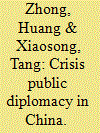

|
|
|
|
|
| Publication |
2014.
|
| Summary/Abstract |
Leon Trotsky, founder of the Soviet Red Army, once lamented "You Lmay not be interested in war, but war is interested in you".' His words are highly relevant to crisis public diplomacy today. Although not enough attention is paid to it, crisis public diplomacy is destined to become vital and complementary to other diplomacies in an era of frequent crisis. It mestic diplomatic strategies and appears to be very conspicuous in international affairs. This was clearly indicated in the report made by former General Secretary Hu Jintao at the 18th Congress of the CPC (Communist Party of China), as follows: "At present, as the global, national and our Party's conditions continue to undergo profound changes, we are faced with unprecedented opportunities for development as well as risks and challenges unknown before." Having a clear understanding of different situations, guarding against risks, dealing with challenges, solving crises and exploiting opportunities have become very real issues. China needs to follow the trend and engage in crisis public pressing times. Through overall coordination it will be control crises. and establish a positive image plays a prominent role in do diplomacy in these able to erase risks to security
|
|
|
|
|
|
|
|
|
|
|
|
|
|
|
|
| 5 |
ID:
132048
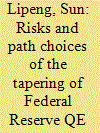

|
|
|
|
|
| Publication |
2014.
|
| Summary/Abstract |
On December 2013, the Federal Open Market Committee (FOMC) formally announced that it would wind down the size of its large-scale asset purchase program. This formally set in motion the exit of quantitative easing (QE). However, at present, the American unemployment rate is still relatively high, the real estate market is gloomy, in?ation is too low, the balance sheet is facing an unexpected increase in risks, and policies are confronted with cost pressures. Under such circumstances, the Fed is faced with multiple challenges in the tapering of QE. QB policy has made great contributions to helping the United States to shake off ?nancial crisis, and the safe and smooth exit of the policy is of the utmost importance to the recovery of the U.S. economy and the reshaping of U.S. advantages. In addition, the Fed 's monetary policy reversal will engender spillover risks and challenges for China 's economy.
|
|
|
|
|
|
|
|
|
|
|
|
|
|
|
|
| 6 |
ID:
132042


|
|
|
|
|
| Publication |
2014.
|
| Summary/Abstract |
A NATO and Western powers begin to take a backseat in Afghanistan 's future, one of the most pressing questions is what role the region can play in helping Afghanistan to become a prosperous and stable nation. Numerous efforts are already underway through multilateral and bilateral forums, yet the key to regional cooperation for Afghanistan' s future lies through closer interaction between Beijing and New Delhi. Drawing on a research project spanning a number of workshops in Beijing, New Delhi and Qatar and involving influential thinkers and experts from China, India, the UK and Afghanistan, this paper will try to map out specific ideas that policymakers in Beijing and New Delhi can explore as avenues of cooperation. Post-2014 Afghanistan will remain a major regional concern for at least the short to medium term. The earlier China and India can develop workable collaborative undertakings, the sooner they can forge a stable and prosperous neighbourhood.
|
|
|
|
|
|
|
|
|
|
|
|
|
|
|
|
| 7 |
ID:
132041
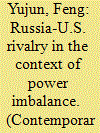

|
|
|
|
|
| Publication |
2014.
|
| Summary/Abstract |
Compared to Soviet-U.S. relations of the Cold War era, contemporary Russia-U.S. relations are less decisively in?uential in shaping the global strategic situation. While evolving, the new relationship between the two sometimes registers dramatic events-Syria and Ukraine, for example-that seem to endanger a proposed "reset" of their bilateral relations. This reset, first mentioned during the presidencies of Dmitry Medvedev in Russia and the first term of Barack Obama in the U.S., was not launched. Since the onset of the global ?nancial crisis, the international strategic situation has further readjusted, and big power relations have remained out of equilibrium. Progress toward improved relations witnessed "apathy" after Vladimir Putin returned to power. Both countries pay less attention to each other in their respective foreign agendas but they are wrestling fiercely in the ?elds of politics, security and geopolitics in spite of an accelerating imbalance of strategic power.
|
|
|
|
|
|
|
|
|
|
|
|
|
|
|
|
| 8 |
ID:
132047
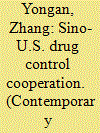

|
|
|
|
|
| Publication |
2014.
|
| Summary/Abstract |
Asia's Golden Triangle and Golden Crescent are two of the world's largest drug-producing areas. They make about 90% of the world's opium-Afghanistan alone accounts for about 74% 0.012).' lllicit drugs
production and tra?ieking in Asia pose a serious threat to China and the U.S.. In recent years, China and the U.S. have been working closer to deal with this threat. Their cooperation, however, has not always been smooth. The Threats as drug production in Asia rises steadily, the number of types of drugs increases, and with globalization and a growing consumer society, international drug trafficking routes targeting China and U.S. markets have become more complicated. The threats to both countries have also grown. First, although opium poppy cultivation in the Golden Triangle has been declining in recent years, it still poses a threat in the 1ong-tcrm because of its large base. According to a report issued by United Nations Office on Drugs and Crime (UNODC), in 2011 poppy plantations covered 51,000
|
|
|
|
|
|
|
|
|
|
|
|
|
|
|
|
| 9 |
ID:
017860


|
|
|
|
|
| Publication |
Oct 2000.
|
| Description |
1-10
|
|
|
|
|
|
|
|
|
|
|
|
|
|
|
|
|
|
|
|
|